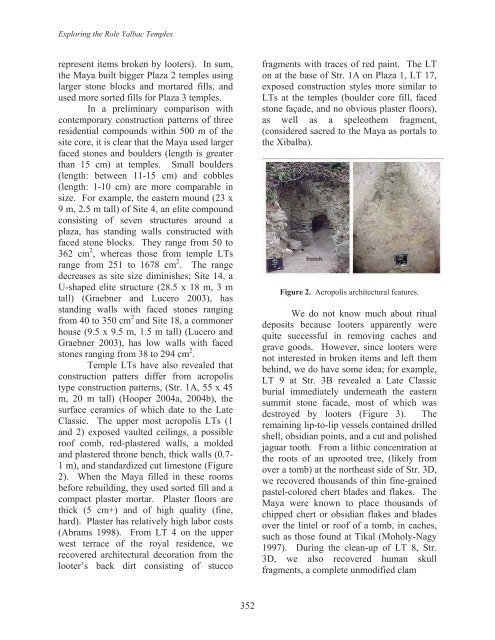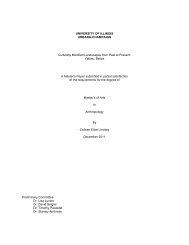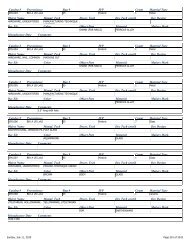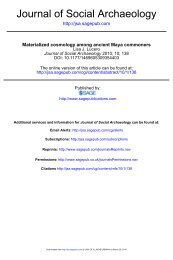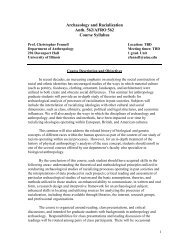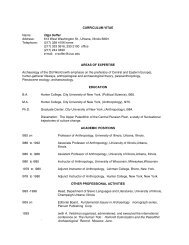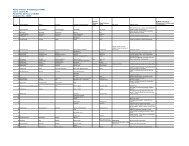2005 Exploring the Roles of Temples at Yalbac. Research Reports ...
2005 Exploring the Roles of Temples at Yalbac. Research Reports ...
2005 Exploring the Roles of Temples at Yalbac. Research Reports ...
You also want an ePaper? Increase the reach of your titles
YUMPU automatically turns print PDFs into web optimized ePapers that Google loves.
<strong>Exploring</strong> <strong>the</strong> Role <strong>Yalbac</strong> <strong>Temples</strong>represent items broken by looters). In sum,<strong>the</strong> Maya built bigger Plaza 2 temples usinglarger stone blocks and mortared fills, andused more sorted fills for Plaza 3 temples.In a preliminary comparison withcontemporary construction p<strong>at</strong>terns <strong>of</strong> threeresidential compounds within 500 m <strong>of</strong> <strong>the</strong>site core, it is clear th<strong>at</strong> <strong>the</strong> Maya used largerfaced stones and boulders (length is gre<strong>at</strong>erthan 15 cm) <strong>at</strong> temples. Small boulders(length: between 11-15 cm) and cobbles(length: 1-10 cm) are more comparable insize. For example, <strong>the</strong> eastern mound (23 x9 m, 2.5 m tall) <strong>of</strong> Site 4, an elite compoundconsisting <strong>of</strong> seven structures around aplaza, has standing walls constructed withfaced stone blocks. They range from 50 to362 cm 2 , whereas those from temple LTsrange from 251 to 1678 cm 2 . The rangedecreases as site size diminishes; Site 14, aU-shaped elite structure (28.5 x 18 m, 3 mtall) (Graebner and Lucero 2003), hasstanding walls with faced stones rangingfrom 40 to 350 cm 2 and Site 18, a commonerhouse (9.5 x 9.5 m, 1.5 m tall) (Lucero andGraebner 2003), has low walls with facedstones ranging from 38 to 294 cm 2 .Temple LTs have also revealed th<strong>at</strong>construction p<strong>at</strong>ters differ from acropolistype construction p<strong>at</strong>terns, (Str. 1A, 55 x 45m, 20 m tall) (Hooper 2004a, 2004b), <strong>the</strong>surface ceramics <strong>of</strong> which d<strong>at</strong>e to <strong>the</strong> L<strong>at</strong>eClassic. The upper most acropolis LTs (1and 2) exposed vaulted ceilings, a possiblero<strong>of</strong> comb, red-plastered walls, a moldedand plastered throne bench, thick walls (0.7-1 m), and standardized cut limestone (Figure2). When <strong>the</strong> Maya filled in <strong>the</strong>se roomsbefore rebuilding, <strong>the</strong>y used sorted fill and acompact plaster mortar. Plaster floors arethick (5 cm+) and <strong>of</strong> high quality (fine,hard). Plaster has rel<strong>at</strong>ively high labor costs(Abrams 1998). From LT 4 on <strong>the</strong> upperwest terrace <strong>of</strong> <strong>the</strong> royal residence, werecovered architectural decor<strong>at</strong>ion from <strong>the</strong>looter’s back dirt consisting <strong>of</strong> stucc<strong>of</strong>ragments with traces <strong>of</strong> red paint. The LTon <strong>at</strong> <strong>the</strong> base <strong>of</strong> Str. 1A on Plaza 1, LT 17,exposed construction styles more similar toLTs <strong>at</strong> <strong>the</strong> temples (boulder core fill, facedstone façade, and no obvious plaster floors),as well as a speleo<strong>the</strong>m fragment,(considered sacred to <strong>the</strong> Maya as portals to<strong>the</strong> Xibalba).Figure 2. Acropolis architectural fe<strong>at</strong>ures.We do not know much about ritualdeposits because looters apparently werequite successful in removing caches andgrave goods. However, since looters werenot interested in broken items and left <strong>the</strong>mbehind, we do have some idea; for example,LT 9 <strong>at</strong> Str. 3B revealed a L<strong>at</strong>e Classicburial immedi<strong>at</strong>ely underne<strong>at</strong>h <strong>the</strong> easternsummit stone facade, most <strong>of</strong> which wasdestroyed by looters (Figure 3). Theremaining lip-to-lip vessels contained drilledshell, obsidian points, and a cut and polishedjaguar tooth. From a lithic concentr<strong>at</strong>ion <strong>at</strong><strong>the</strong> roots <strong>of</strong> an uprooted tree, (likely fromover a tomb) <strong>at</strong> <strong>the</strong> nor<strong>the</strong>ast side <strong>of</strong> Str. 3D,we recovered thousands <strong>of</strong> thin fine-grainedpastel-colored chert blades and flakes. TheMaya were known to place thousands <strong>of</strong>chipped chert or obsidian flakes and bladesover <strong>the</strong> lintel or ro<strong>of</strong> <strong>of</strong> a tomb, in caches,such as those found <strong>at</strong> Tikal (Moholy-Nagy1997). During <strong>the</strong> clean-up <strong>of</strong> LT 8, Str.3D, we also recovered human skullfragments, a complete unmodified clam352


